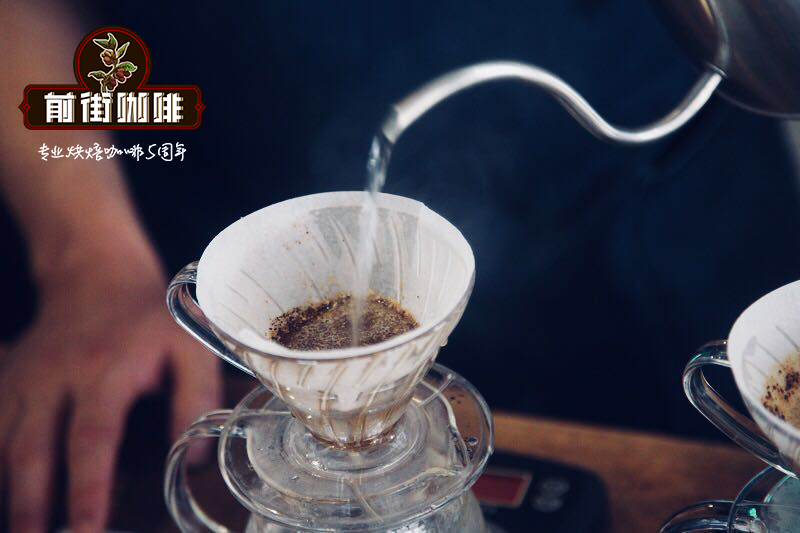The world's three major coffee producing areas is a brief introduction to coffee beans three major producing areas flavor difference introduction

Professional coffee knowledge exchange more coffee bean information please follow the coffee workshop (Wechat official account cafe_style)
A brief introduction to the difference of flavor between Qianjie and three coffee producing areas
The top ten coffee producing countries in the world
According to ICO International Coffee Organization, the top ten coffee production is about 8.6 million metric tons (147337 60KG 1000 bags), of which Arabica accounts for 59% and Robusta accounts for 41%. The top ten coffee producing countries and beans in the world are shown in the table below.
Ranking the proportion of beans in countries
NO.1 Brazil 30.2% is dominated by Arabica.
19.2% of NO.2 Vietnam is dominated by Robusta.
9.4% of NO.3 Colombia is dominated by Arabica.
7.7% of NO.4 Indonesia is dominated by Robusta.
NO.5 4.5% of Ethiopia is dominated by Arabica
4.1% of NO.6 India is dominated by Robusta.
NO.7 Honduras is dominated by Arabica.
3.3% of NO.8 Uganda is dominated by Robusta.
2.7% of NO.9 Mexico is dominated by Arabica.
2.4% of NO.10 Guatemala is dominated by Arabica.
Brazil (Brazil) famous representative coffee: Santos
Brazil is the largest coffee producer in the world, with the first total output in the world, accounting for about 1% of the world's total output. Brazil is mainly produced in the central and southern provinces. Brazil is suitable for growing coffee, the terrain is relatively flat, coffee gardens are mostly less than 1200 meters above sea level, and there is no shade from big trees, because raw and ripe berries are picked at the same time, so it is not fine coffee.
The quality of Brazilian coffee is average but less excellent, its bean quality is soft, and it is obviously not resistant to heat in the roasting process. Santos is more famous among all varieties, which is named after its export port Santos. Brazilian coffee beans are neutral and can be tasted individually (though a bit monotonous), or mixed with other kinds of coffee beans to form a comprehensive coffee, which is generally considered to be indispensable in blending.
Colombia (Colombia) well-known representative coffee: Colombia
Colombia is the world's second largest exporter of coffee, accounting for about 15% of global production. Its coffee trees are planted in three mountains stretching north and south, with only Arabica species. Although its output ranking is lower than that of Brazil, the coffee beans are of good quality, rich and unique flavor, sweet in acidity and moderate bitterness, which is very suitable for single drink or mixture. Colombian beans and Brazilian beans are both the best choice for basic beans of blended coffee, but their flavor is more mellow and more fragrant than Brazilian beans. In addition to individual products, they are also often used in blending coffee to increase the sweetness of coffee and to blend the bitterness of other coffee.
Vietnam well-known representative coffee: Vietnam
Generally speaking, when it comes to coffee producing areas, we will subconsciously think of some countries in Central and South America or Africa, such as Ethiopia and Colombia. In fact, Vietnam surpassed these countries as early as 1994 to become the second largest producer in the world. In 1857, the French Jesuit introduced coffee to Vietnam for the first time, and Vietnam, which originally drank tea, began to drink coffee. In 1994, when the United States lifted the embargo on Vietnam, it happened that the price of Brazilian coffee soared by 39% due to cold damage. Vietnamese coffee took advantage of its large quantity and low price. This turning point has even helped Vietnam's economic transformation. Before 1994, 60% of the people lived below the poverty line, but only 10% remained after 1994.
Coffee currently accounts for about 3% of Vietnam's GDP and is Vietnam's largest export. Vietnam mainly grows Robusta beans, which are strong in flavor and high in caffeine, but they are not afraid of diseases and insect pests and are cheap, attracting many large coffee factories (such as Nestl é) to set up factories in Vietnam. In recent years, the government has devoted itself to improving the quality of coffee, replacing old trees and planting Arabica beans to increase profits.
Knowledge expansion: Colombia is the third largest producer of coffee in the world, but Colombian coffee is famous for its quality rather than production. Has a unique coffee growing environment ─── low latitude high altitude, rainfall and soil conditions are very suitable for the growth of Arabica beans.
In short: Qianjie is a coffee research hall, happy to share the knowledge about coffee with you, we share unreservedly just to make more friends fall in love with coffee, and there will be three low-discount coffee activities every month. The reason is that Qianjie wants to make more friends drink the best coffee at the lowest price, which has been Qianjie's tenet for 6 years!
END
Important Notice :
前街咖啡 FrontStreet Coffee has moved to new addredd:
FrontStreet Coffee Address: 315,Donghua East Road,GuangZhou
Tel:020 38364473
- Prev

There are several major coffee producing areas | A brief introduction to the flavor characteristics of the three major coffee producing areas in the world
Professional coffee knowledge exchange more coffee bean information please follow the coffee workshop (Wechat official account cafe_style) front street-the flavor of the three major coffee producing areas [Brazil] the largest coffee producer, various grades, types of coffee accounted for 1/3 of the global consumption, has a place in the global coffee market, although Brazil faces more natural disasters than other regions
- Next

Three major coffee growing areas in the world | A brief introduction to the varieties and flavor characteristics of coffee producing areas in Brazil
Professional coffee knowledge exchange more coffee bean information please follow the coffee workshop (Wechat official account cafe_style) front street-the world's three major coffee growing areas | Brazil Brasil Central and South America is the world's largest coffee producing area, the amount of output here significantly affects the global price of raw coffee, among which Brazilian coffee is the largest producing country in Central and South America.
Related
- Beginners will see the "Coffee pull flower" guide!
- What is the difference between ice blog purified milk and ordinary milk coffee?
- Why is the Philippines the largest producer of crops in Liberia?
- For coffee extraction, should the fine powder be retained?
- How does extracted espresso fill pressed powder? How much strength does it take to press the powder?
- How to make jasmine cold extract coffee? Is the jasmine + latte good?
- Will this little toy really make the coffee taste better? How does Lily Drip affect coffee extraction?
- Will the action of slapping the filter cup also affect coffee extraction?
- What's the difference between powder-to-water ratio and powder-to-liquid ratio?
- What is the Ethiopian local species? What does it have to do with Heirloom native species?

